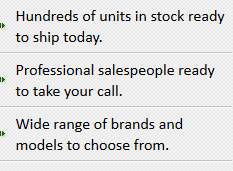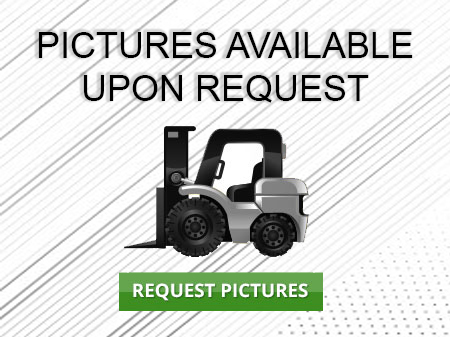Rough Terrain Forklift Surprise
Used Rough Terrain Forklift Surprise - Broadly defined, a forklift truck uses two forks to load, transport and unload material. The two main categories of forklifts are industrial forklift and rough terrain forklift.
Industrial forklifts are mainly used in loading docks and warehouse applications with smooth and level surfaces. By contrast, the second category of forklifts, rough terrain forklifts, are commonly used to run on uneven and rocky surfaces. Due to size, tires, and weight capacity, a rough terrain lift is primarily used outdoors, often at construction sites. The main difference between rough terrain and industrial forklifts is the cushion tires that are on industrial forklift models. Rough terrain forklifts, on the other hand, are fitted with pneumatic tires, a type of tractor tire allowing for better traction and flotation properties. Industrial forklifts can be powered by internal combustion engines but are more frequently powered by an electrical source, such as battery or fuel cell whereas rough terrain forklifts are almost always powered by an internal combustion engine.
Types of Class 7 Rough Terrain Forklift Trucks
There are three main types of Class 7 Rough Terrain Forklift Trucks:
1. Straight mast forklifts;
2. Telehandler forklifts; and
3. Rotating telehandler forklifts.
Rough terrain forklifts function well in treacherous locations that are often found in construction sites and military settings. The rough terrain models travel and perform well in difficult locations. Additional consideration needs to be given for rough terrain forklift options while raising loads in difficult conditions in order to stay safe from tipping over. For safety reasons, it is vital the forklift maintains stability before moving, lifting or lowering. Rough terrain forklift operators must practice correct lifting techniques to remain stable on the ground.
Straight Mast Forklifts
The straight mast forklift design enables easy transport around rough terrain locations including construction and demolition sites. Pneumatic cushion tires allow this forklift better maneuverability and accessibility around difficult terrain. Pneumatic tires allow the machine to successfully traverse difficult terrain. Most straight mast forklift units have 2WD or 4WD configurations. Most straight mast forklifts are powered by diesel or propane fuel, allowing them to be used indoors for short periods but are more suited to outdoor applications. The lift capacities of straight mast forklifts are similar to most standard forklifts with a range of approximately 5,000 to 36,000 pounds.
Telehandler or Telescopic Handler Forklifts
The distinct telescoping boom on telehandlers and telescopic handler forklifts contribute to the unit’s name. Telescoping booms are handy for allowing the machine to load and place items at different lift heights and distances in front of the forklift. Better reachability delivers greater flexibility to the forklift operator while placing loads.
Featuring two wheels found at the front and two wheels at the rear, the standard telehandler is a long and low machine. Mounted at the back of the forklift, the telescopic boom is on a pivot that is located many feet above the forklift frame. The fuel tank and hydraulic fluid tank are found opposite to the forklifts’ cab that is typically mounted on the left side. Within the frame itself, the transmission and engine are located along the center-line of the forklift. This popular design showcases a balanced forklift which is ideal for the machine’s stability with lifting, moving and lowering items.
Telehandler units offer significantly higher lifting heights compared to standard units. High-reach telehandlers can extend their full load capacity to 56 feet. The compact telehandlers can extend their full load capacity from 18 feet. The load capacities of these machines range from five thousand pounds to twelve thousand pounds.
All-wheel steering is popular for all-terrain forklifts and provides increased maneuverability. This, along with power shift transmission and other steering features, means that the operator can move the lift in as close proximity to the work area as possible.
Recent telehandler units showcase top-of-the-line ergonomic design to generate increased comfort and operator satisfaction. These features include tilted steering options and roomier cabs to increase operator comfort. These ergonomic upgrades have been shown to lessen repetitive stress injuries and lessen operator fatigue.
The majority of telehandler forklifts are operated by a single joystick. The joystick is responsible for the hydraulic system and the boom operations.
Non-marking tires are a feature that telehandler forklifts can benefit from by allowing these units to be utilized for maintenance on billboards and signs and on stadiums and buildings.
Rotating Telehandler or Roto Telescopic Handler Forklifts
Rotating telehandler or roto telescopic handler forklifts have many features in common with the standard telehandler forklift. These include the rotating telehandler’s ability to lift heavy weight to great heights. However, these forklifts have the added ability to rotate the forklift on a turntable. Rotating the forklift a complete three-hundred-and-sixty degrees creates a larger working location without the need of repositioning the forklift.
Commonly, rotating telehandlers have another joystick to handle the rotation portion separately from the lift function. As with the standard telehandler forklift, rotating telehandlers are available with added features including power assist steering, four-wheel drive and minimized slip differential on the rear axle to boost traction and for additional safety.
With the added rotating ability of these forklifts, comes additional safety considerations. Because of this, rotating telehandler rough terrain forklifts come with stabilizers to increase the safety when rotating loads from one side of the forklift to the other. There are some rotating telehandlers that are designed to move heavy weights without stabilizers to reduce the time it takes to reposition the forklift for work in other areas of the jobsite.
The standard telehandler offers fixed cab components and rotator telehandlers are generally smaller in comparison. Because of this, their load capacities are also smaller than the standard telehandler. Rotating telehandlers offer load capacities ranging from 4000 to 10,000 lbs. and lift heights between fifteen to eighty feet.
Both telehandlers and rotator telehandlers can be used as a crane when fitted with a winch attachment. This means that these forklifts can sometimes allow a project to forego the need for a crane at the jobsite, saving time, expense and workspace.
Advancements for Rough Terrain Forklifts
Popular rough terrain forklift attachments include rotating fork carriages, booms, articulating booms and winches. Because of the importance of forklift attachments in their ability to adapt forklifts to many different types of specific jobs, it is expected that the creation and availability of new rough terrain forklift attachments will continue to increase.
The majority of advancements will be delivered as safety features built to enhance the rough terrain models. The latest safety upgrades include automatic load restriction and other features. This system weighs a load automatically and then calculates the safe reach distance of the load while considering the extension and boom angle. An alarm will go off once the safe distance is reached. This alerts the operator that immediate adjustments need to be made to the boom angle, reach distance or load weight.
Rough Terrain Forklift PDF
Stock Number: 267846 GL
Make: Liftking
Model: LK12000
Year: 2003
| Stock Number |
267846 GL |
| Make |
Liftking |
| Model |
LK12000 |
| Year |
2003 |
| Category |
Rough Terrain Forklift |
Stock Number: DP-MAN008 GL
Make: MANITOU
Model: MH25-4T
Year: 2016
| Stock Number |
DP-MAN008 GL |
| Make |
MANITOU |
| Model |
MH25-4T |
| Year |
2016 |
| Category |
Rough Terrain Forklift |
Stock Number: 209058 GL
Make: LIFTKING
Model: LK12M42
Year: 2015
| Stock Number |
209058 GL |
| Make |
LIFTKING |
| Model |
LK12M42 |
| Year |
2015 |
| Category |
Rough Terrain Forklift |
Stock Number: LS15257 GL
Make: JCB
Model: 930
Year: 2013
| Stock Number |
LS15257 GL |
| Make |
JCB |
| Model |
930 |
| Year |
2013 |
| Category |
Rough Terrain Forklift |
Stock Number: EQC008213 GL
Make: MANITOU
Model: M50
Year: 2017
| Stock Number |
EQC008213 GL |
| Make |
MANITOU |
| Model |
M50 |
| Year |
2017 |
| Category |
Rough Terrain Forklift |
Stock Number: 208325 GL
Make: MANITOU
Model: M50.4
Year: 2015
| Stock Number |
208325 GL |
| Make |
MANITOU |
| Model |
M50.4 |
| Year |
2015 |
| Category |
Rough Terrain Forklift |



























